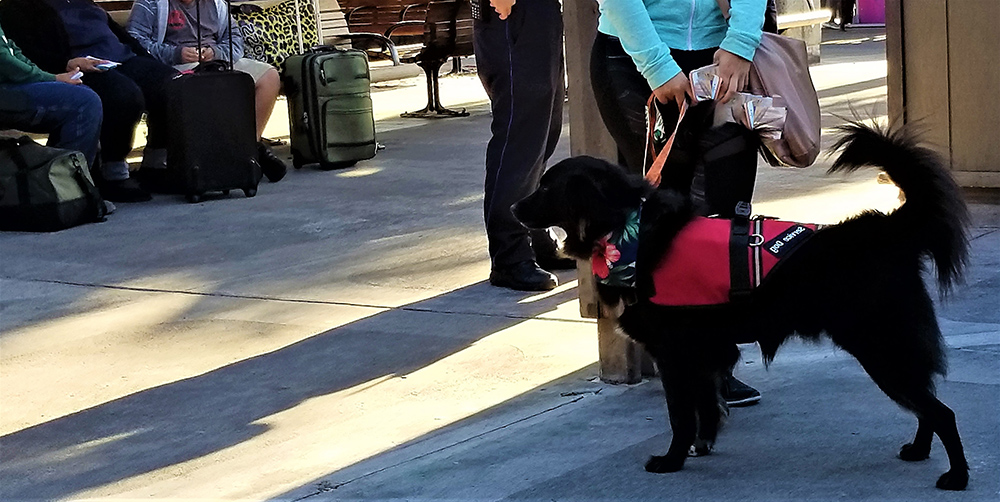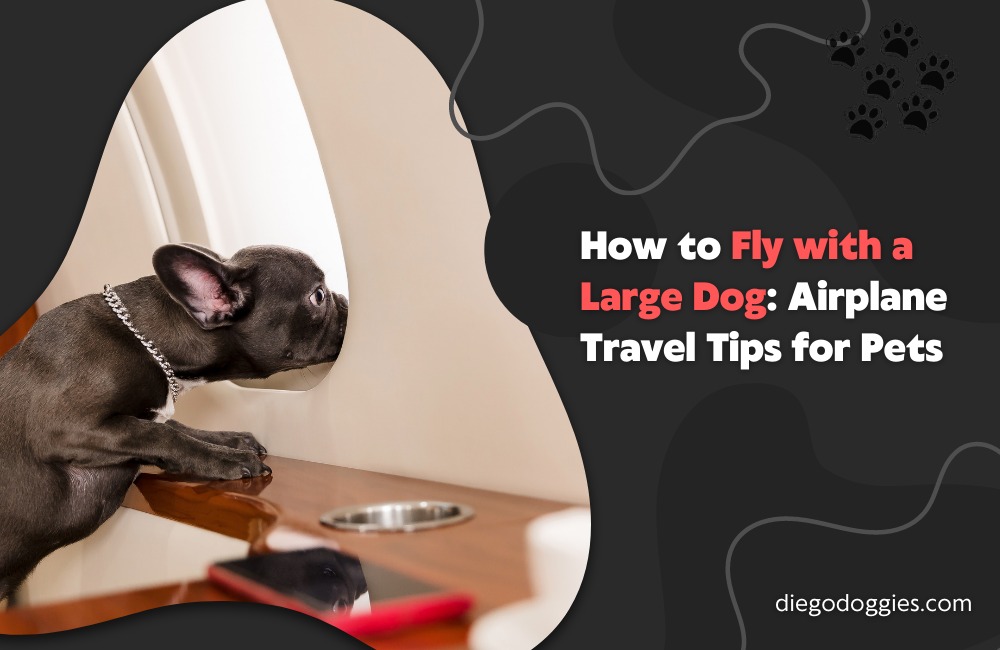Are you dreading your upcoming trip because you have to fly with your large dog? Don’t worry, you’re not alone. Flying with a pet can be stressful for both you and your furry friend. In this blog post, we will share some tips that will help make the process a little easier. Follow these tips and your trip should go smoothly!
Dog Travel Requirements and Restrictions
The first step is to check with the airline you will be flying as their rules and regulations vary. Some airlines do not allow dogs over a certain weight or of certain breeds, so it is important to check in advance. Check the details for American Airlines by clicking here and United Airlines by clicking here and Delta by clicking here.
If your dog is allowed on the plane, you will need to purchase a ticket for them. You can do this either at the airport or in advance when you book your own ticket. The price of the ticket will depend on the weight of your dog and whether they will be flying in the cabin or in cargo.
Service dogs in the United States have travel rights which can be seen by clicking Service Animals | US Department of Transportation
If your dog is flying in the cabin, they will need to be able to fit comfortably in a pet carrier that can fit under the seat in front of you. The carrier must have ventilation on all sides and be leak-proof. You will also need to provide proof of vaccinations and a health certificate from a licensed veterinarian.
If your dog is flying in cargo, it will need to be able to fit in a kennel that meets the requirements of the airline. The kennel must be large enough for your dog to stand up, turn around, and lie down comfortably. It must also have ventilation on all sides and be leak-proof. You will also need to provide proof of vaccinations and a health certificate from a licensed veterinarian.
The temperature restrictions for dogs vary by airline. Most airlines have a maximum temperature limit of 85 degrees Fahrenheit for dogs, but some airlines have a lower limit of 80 or even 75 degrees Fahrenheit. It is important to check with your airline before booking your flight to find out their specific temperature restrictions for dogs. See the links above for American Airlines and United Airlines.
Consult Your Veterinarian
You should always consult your veterinarian before you fly with your pet. Your vet can offer helpful tips specific to your animal’s needs and make sure that they are healthy enough to travel. They can also provide you with a health certificate if required by the airline.
Booking Your Flight
The first step is to book your flight. When you call the airline, let them know that you will be traveling with a pet. They may have specific rules and regulations regarding traveling with pets. Be sure to ask about these before booking your ticket. You will also need to book a seat for your dog. Some airlines allow dogs to sit in the cabin with their owners, while others require them to travel in the cargo hold.
Your next step is to make sure that your dog is up-to-date on all of its vaccinations. You will need to bring copies of your pet’s health records with you when you travel. Most airlines require that dogs have a rabies vaccination. You should also have your dog microchipped, in case it gets lost while traveling.
Dog Quarantine
If you’re planning on flying with your dog, there are a few things you need to know in order to make the trip as smooth as possible for both you and your furry friend. This is to prevent the spread of rabies and other diseases that are not currently present in the city.
The goal of this article is to give you access to the best information. Dog quarantine may be applicable to your situation if you are coming into California from overseas. A specific article about this subject from the California Department of Public Health can be read by clicking here.
Your dog will also need to be micro-chipped and have the required vaccinations up to date. You will need to provide proof of these things when you apply for the Certificate of Quarantine Health Examination.
Tools for Flying with a Dog
If you’re flying with a large dog, there are some tools that can make the process easier. A pet carrier that’s big enough for your dog to stand up and move around in is a must. You’ll also need a leash to keep your dog under control while you’re in the airport. And don’t forget the food and water bowl!
Making sure your dog is comfortable during the flight is important. A good way to do this is to acclimate them to the carrier ahead of time. Put their food and water in the carrier and let them get used to it. You may even want to take a few practices runs around the block with the carrier before you head to the airport.
1. Dog Carriers: Dog carriers that fit under the seat are typically limited to dogs that weigh 20 pounds or less, which unfortunately excludes a lot of large breeds.
For larger dogs, traveling in the cargo hold is the only option. The good news is that most airlines have extensive experience flying animals and have strict guidelines to ensure their safety.
2. Dog Bed: Your dog will need a comfortable place to sleep during the flight. A soft bed or crate will do the trick.
3. Chew Toys: Bring along a few of your dog’s favorite chew toys to keep them occupied during the flight.
4. Water and Food: Be sure to bring along enough water and food for your dog to last the entire flight.
5. Poop Bags: Don’t forget to pack a few extra poop bags, just in case.
6. Collar and tags: Even if your dog never runs off, it’s important to have ID on them in case they do manage to escape from their carrier during a layover or if the carrier is lost. A collar and tags will also help airline personnel return your dog to you if they get loose in the airport.
7. Grooming: Make sure your dog is well-groomed: This isn’t just for appearance’s sake (although it is important to make sure your dog looks presentable before flying). Grooming will also help to cut down on the amount of shedding during the flight, which will keep your dog and your seatmate happy.

Wondering How to Fly With A Large Dog? Here Are Some Quick Helpful Tips:
1. Check with the Airline for their pet travel policies before booking. See United Airlines and American Airlines policy links above.
2. Choose an airline that is pet-friendly and offers in-cabin flying for pets.
3. Book a direct flight if possible to minimize travel time and stress for your dog.
4. Make sure your dog is healthy enough to fly. Check with your veterinarian beforehand and get a health certificate if required by the airline.
5. Get your dog accustomed to their crate or carrier well in advance of the flight. Practice making it a positive experience by feeding them meals in their crate and giving them plenty of treats.
6. On the day of the flight, arrive early at the airport so you have time to check-in and get your dog settled before boarding.
7. During the flight, give your dog lots of reassurance and plenty of breaks to stretch their legs.
Frequently Asked Questions
These airlines all allow pets in the cabin on select flights. Fees and restrictions vary by airline, so be sure to check their individual policies before booking your flight.
Some airlines also require that you book a non-stop flight and that your pet is at least eight weeks old.
You may also be asked to demonstrate how your animal performs these tasks. Service animals are not subject to the same pet policies as other animals, so be sure to check with the airline before booking your flight.
Conclusion
So, there you have it! Our top tips for flying with a large dog. By following these simple steps, you can make the experience much less stressful for both you and your pet.
Related Contents
- The Eight Best Dog Breeds for RV Living
- How Much Does Dog Training Cost? A Comprehensive Guide
- How to Make Crate Training Easy for Your Puppy
- How to Teach a Dog to Smile: Fun and Easy Tips
- How to Train Your Dog to Roll Over in 7 Easy Steps
- Important Essential Training Tools for Dogs
- San Diego Dog Park Safety Tips, Training, and Dog Accessories
- Seven Top Tips: How to Train Your Dog to Hunt


2 thoughts on “How to Fly with a Large Dog: Airplane Travel Tips for Pets”